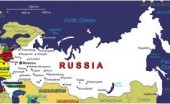Re Ian Bremmer 'Could third-party candidates upend the 2024 US election?' 3 April The current political movement in the USA…
U.S.: Environment & energy
Written by Diana Thebaud Nicholson // January 4, 2017 // Environment & Energy, U.S. // Comments Off on U.S.: Environment & energy
4 January
Making Waves: A new study in the journal Science Advances confirms that the world’s oceans have steadily warmed for the past five decades, flying in the face of speculation by Representative Lamar Smith that similar findings from the National Oceanic and Atmospheric Administration were politically biased. The research underscores how climate change is a scientific fact—and thus solutions can and should come from both sides of the aisle. Toward that goal, a small group of GOP environmentalists is hopeful that President-elect Donald Trump—despite his ominous record of denying climate science—will pursue solutions using the free market. In the meantime, President Obama has shored up another environmental legacy: With the creation and expansion of several marine monuments, he’s protected more ocean than any other U.S. president.
2016
30 December
Monumental Acts: President Barack Obama exercised the executive powers afforded to him by the 1906 Antiquities Act to create the Bears Ears National Monument in southeastern Utah. The move, which placed the region under federal protection, was lauded by environmentalists and Native leaders, but infuriated Republican lawmakers who had their own plans for the area. It marks the 29th time Obama has invoked his power to protect public land, and is one the incoming administration will likely be unable to undo.
Obama cemented his environmental legacy. With three weeks left in his presidency, Barack Obama announced the creation of national monuments in Utah and the Nevada desert, protecting sacred tribal sites. Obama has been one of the most environment-friendly presidents in recent history, protecting 553 million acres (2.24 million sq km) of land and waters, often to heavy opposition from developers and conservatives.
20 December
President Obama bans oil drilling in large areas of Atlantic and Arctic oceans
(WaPost) President Obama moved to solidify his environmental legacy Tuesday by withdrawing hundreds of millions of acres of federally owned land in the Arctic and Atlantic Ocean from new offshore oil and gas drilling.
Obama used a little-known law called the Outer Continental Shelf Lands Act to protect large portions of the Chukchi and Beaufort seas in the Arctic and a string of canyons in the Atlantic stretching from Massachusetts to Virginia. In addition to a five-year moratorium already in place in the Atlantic, removing the canyons from drilling puts much of the eastern seaboard off limits to oil exploration even if companies develop plans to operate around them.
The announcement by the White House late in the afternoon was coordinated with similar steps being taken by Canadian Prime Minister Justin Trudeau to shield large areas of that nation’s Arctic waters from drilling. Neither measure affects leases already held by oil and gas companies and drilling activity in state waters.
“These actions, and Canada’s parallel actions, protect a sensitive and unique ecosystem that is unlike any other region on earth,” the White House said in a statement. “They reflect the scientific assessment that, even with the high safety standards that both our countries have put in place, the risks of an oil spill in this region are significant and our ability to clean up from a spill in the region’s harsh conditions is limited.
White House officials described their actions to make the areas off limits to future oil and gas exploration and drilling as indefinite. Officials said the withdrawals under Section 12-A of the 1953 act used by presidents dating to Dwight Eisenhower cannot be undone by an incoming president. It is not clear if a Republican-controlled Congress can rescind Obama’s action.
15 December
Trump, Putin and the Pipelines to Nowhere
You can’t understand what Trump’s doing to America without understanding the “Carbon Bubble”
By Alex Steffan
(Medium) This is a cabinet custom-built to protect carbon industry investors… especially, perhaps, one.
No One Cares More about the Carbon Bubble than Putin
Trump’s ties to Russian espionage suddenly make more sense in this light.
If you were going to ask why a country like Russia would risk a war to interfere with American politics, look at what the Russian economy is.
Russia is a petrostate. It’s the number one gas exporter and number two oil exporter in the world, but its economy is otherwise stagnant and out-of-date. Those oil and gas assets are controlled by a small number of oligarchs gathered around Putin, the former head of the KGB. Those oligarchs may be the one group of investors who stands to lose the most from the popping of the Carbon Bubble.
Russia’s major national asset is their potential to develop Arctic oil fields opened up by climate change — which won’t happen if investors pull out of oil. If it’s obvious that this oil is unburnable, there’s no point in building all those oil-drilling platforms and pipelines.
… add in all the other Bubble-expanding projects and ploys, pipelines and hotels, and you begin to see the magnitude of the scam here. The difference between the Carbon Bubble deflating rapidly now and popping spectacularly in a decade or more could mean literally trillions more dollars in profits for the kind of people now helicoptering into Washington.
But that same delay would also bring on climate catastrophe, damage our democracy and bring financial ruin for the investors who are left holding those assets when the bubble pops. If history is any guide, those investors will be pensions and mutual funds and small timers — in other words, regular people.
8 December
EPA fears ‘unprecedented disaster’ for environment over Scott Pruitt pick
Senate Democrats vow to fight Trump’s nominee to lead the EPA, a climate denier who has sued the agency multiple times as attorney general of Oklahoma
(The Guardian) Democrats have promised to stage a last-ditch effort to thwart the appointment of Scott Pruitt as administrator of the Environmental Protection Agency, amid fears within the agency that he will trigger an “unprecedented disaster” for America’s environment and public health.
Donald Trump has nominated Pruitt to lead an agency he has sued multiple times in his role as attorney general of Oklahoma. Pruitt has vowed to dismantle serried environmental rules and is currently involved in a legal effort by 27 states to overturn Barack Obama’s clean power plan, the president’s centerpiece policy to reduce greenhouse gas emissions.
“The American people are tired of seeing billions of dollars drained from our economy due to unnecessary EPA regulations, and I intend to run this agency in a way that fosters both responsible protection of the environment and freedom for American businesses,” Pruitt said in a statement.
Trump Team Memo Hints at Big Shake-Up of U.S. Energy Policy
(Bloomberg) The transition team has asked the agency to list employees and contractors who attended United Nations climate meetings, along with those who helped develop the Obama administration’s social cost of carbon metrics, used to estimate and justify the climate benefits of new rules. The advisers are also seeking information on agency loan programs, research activities and the basis for its statistics, according to a five-page internal document circulated by the Energy Department on Wednesday. The document lays out 65 questions from the Trump transition team, sources within the agency said.
The document also signals which of the department’s agencies could face the toughest scrutiny under the new administration. Among them: the Advanced Research Projects Agency-Energy, a 7-year-old unit that has been a critical instrument for the Obama administration to advance clean-energy technologies.Since going into operation in 2009, ARPA-E, as it is known, has provided about $1.3 billion in funding to more than 475 projects involving grid-scale batteries, power storage, biofuel production, wind turbines and other technology, according to a May report on the agency. Trump’s energy landing team is seeking “a complete list of ARPA-E’s projects” and wants information about the “Mission Innovation” and “Clean Energy Ministerial” efforts within the department. (Updated 9 December)
5 December
Trump Meets With Al Gore on Climate Issues Amid Pressure From His Children
Effort could clash with president-elect’s aim of boosting energy production from fossil fuels
(WSJ) [Ivanka] Trump, who sought the meeting with the former vice president, has been a moderating influence on her father’s blunt brand of conservatism. Senior aides have said she is one of the few people in his circle able to persuade the president-elect to change a position without upsetting him. …
Mr. Trump’s position on environmental issues may not be entirely fleshed out. But he has left little doubt of his desire to boost the coal industry, beef up domestic energy production, cut regulations and take other actions that worry environmentalists.
Mr. Trump’s eldest son, Donald Trump Jr., said during the campaign his father would “keep public lands public and accessible” while also pushing to develop resources.
Mr. Gore has said electing Mr. Trump could lead to a “climate catastrophe.” But while Mr. Trump’s transition has reflected the value he places on loyalty, he has also shown a taste for unexpected meetings with former rivals and critics. …
Mr. Gore described the meeting as “very productive.” …
Conservative backers of the Trump administration said they weren’t worried about Monday’s meetings altering Mr. Trump’s views on climate change.
“I’m not losing any sleep over it,” said Chris Warren, spokesman for the American Energy Alliance, a conservative energy group whose president, Tom Pyle, is on Mr. Trump’s transition team. “I think President-elect Trump has made it very clear that he doesn’t subscribe to Al Gore’s radical, out-of-touch philosophy.”
4 December
Protesters Gain Victory in Fight Over Dakota Access Oil Pipeline
(NYT) The Standing Rock Sioux Tribe won a major victory on Sunday in its battle to block an oil pipeline being built near its reservation when the Department of the Army announced that it would not allow the pipeline to be drilled under a dammed section of the Missouri River.
The Army said it would look for alternative routes for the $3.7 billion Dakota Access pipeline. Construction of the route a half-mile from the Standing Rock Sioux reservation has become a global flash point for environmental and indigenous activism, drawing thousands of people out here to a sprawling prairie camp of tents, tepees and yurts.
“The best way to complete that work responsibly and expeditiously is to explore alternate routes for the pipeline crossing,” Jo-Ellen Darcy, the Army’s assistant secretary for civil works, said in a statement. The move could presage a lengthy environmental review that has the potential to block the pipeline’s construction for months or years.
But it was unclear how durable the government’s decision would be. Sunday’s announcement came in the dwindling days of the Obama administration, which revealed in November that the Army Corps of Engineers was considering an alternative route. The Corps of Engineers is part of the Department of the Army.
Native Water Protectors, Veterans, And Activists At Standing Rock Got Zero Attention On Major Sunday Shows Again
UPDATE: Hours after the Sunday political talk shows ignored the story, the Army Corps of Engineers announced that they will deny the current route for the pipeline in favor of exploring alternate routes.
(Media Matters) Sunday morning political talk shows entirely ignored the ongoing demonstration at the Standing Rock Sioux Reservation, continuing a troubling pattern of scant media attention being paid to the historic protests and the violent crackdown on the movement for environmental, civil, and Native peoples’ rights.
Law enforcement and private security officers armed with rubber bullets, water cannons, and dogs have clashed with peaceful protesters at the reservation in North Dakota, where Native demonstrators known as water protectors have sought to delay, and ultimately redirect or derail, construction on the Dakota Access Pipeline, which is currently slated to run near the reservation. The pipeline, which was originally supposed to be built near Bismarck, was redirected near the reservation after residents of Bismarck raised concerns that the pipeline would contaminate their water supply. The protest has become “the longest-running protest in modern history” with “the largest, most diverse tribal action in at least a century, perhaps since Little Bighorn.”
Despite the ongoing violent retaliation against the activists by law enforcement personnel, the December 4 editions of the major Sunday morning political talk shows — including ABC’s This Week, CBS’ Face the Nation, CNN’s State of the Union, Fox’s Fox News Sunday, and NBC’s Meet the Press — entirely ignored the events at Standing Rock.
The Sunday political talk shows’ outrageous Standing Rock blackout is in line with how cable news has covered, or not covered, the protests. From October 26 through November 3, CNN, Fox News, and MSNBC combined spent less than an hour covering the ongoing demonstration and violent law enforcement response. Fox News stood out for its minimal coverage, devoting just four and a half minutes to reporting on the events during the time frame analyzed. A review of internal Media Matters records shows that the five main Sunday shows have failed to devote time to the events at Standing Rock since at least September.
3 December
Donald Trump’s daughter Ivanka ‘to fight climate change’ despite his scepticism
Mr Trump has said he has an ‘open mind’ on global warming since election victory
(The Independent) Ivanka Trump wants to become an ambassador for the fight against climate change, according to reports, despite her father’s repeated scepticism.
President-elect Donald Trump has described climate change as a hoax invented by the Chinese to manipulate US markets.
But his high-flying businesswoman daughter, who served as a key liberal-leaning personality within Mr Trump’s campaign, is reportedly lining up an environmental public role.
Politico claims a source says the issue will be one of the 35-year-old’s signature themes while the billionaire tycoon is in power.
“Ivanka is in the early stages of exploring how to use her spotlight to speak out on the issue,” said the unnamed source.
Former Apprentice personality Mr Trump, tweeting in 2012, said global warming was “created by and for the Chinese in order to make US manufacturing non-competitive”.
2 December
Bo Lidegaard argues that the US president-elect’s ability to derail global progress toward a green economy is more limited than many believe.
Climate Change in the Trumpocene Age
(Project Syndicate) In the year since the Paris climate agreement was concluded, the world’s efforts to limit global warming seemed to gain momentum. How worried should the world be about the prospect that US President-elect Donald Trump and the fossil-fuel lobbyists populating his administration will derail progress?
How might US climate-change policies change under Trump? The initial signs do not bode well. As Oxford University Chancellor Chris Patten notes, Trump “has already appointed Myron Ebell, an outspoken climate change denier, to oversee the transition at the US Environmental Protection Agency.” Under US President Barack Obama, the EPA was at the forefront of American efforts to reduce greenhouse-gas emissions, and to phase out dirty energy sources such as coal. Those efforts will almost certainly be scrapped if Trump is taking advice from Ebell, the director of the Center for Energy and Environment at the Competitive Enterprise Institute – which has received funding from hydrocarbon producers.
1 December

US businesses push against Trump’s attempts to dismiss climate change
Environmentally friendly groups at Companies vs Climate Change said they will work to make sure Trump won’t undo all the progress the country has made
(The Guardian) From his claim that global warming was a gigantic hoax masterminded by China to his promise to pull the United States out of the landmark Paris agreement, Donald Trump’s surprise election win was widely decried by those who feared that recent progress in tackling climate change was about to come undone.
But a growing number of environmentally friendly American businesses – including major airlines and banks, as well as energy, tech and pharmaceutical companies – are pushing back against the president-elect’s attempts to dismiss climate change concerns and are planning to take the lead in the drive to make the US a worldwide leader at slowing or reversing the damage.
At the first Companies vs Climate Change conference in Fort Lauderdale on Wednesday, a succession of company executives, sustainable business experts and environmental activists spoke of the need for corporate America to step up efforts to help guide policy and fight what many see as the biggest threat facing the world today.
21 November
Obama Scraps Arctic Drilling Ahead Of Trump Presidency
The Obama administration is rushing to get a flurry of priorities done before Donald Trump takes office. One of those items was a five-year lease plan from the Department of Interior, for the years 2017 through 2022, which includes territories the federal government plans on auctioning off for oil and gas drilling on the outer continental shelf. On November 18, Interior released its plan, and notably absent from the plan was acreage in the Arctic and Atlantic Oceans, a sign that President Obama wants to wall off those areas from future development.
The proposed five-year plan includes 11 potential lease sales across four areas – three in the Gulf of Mexico and one in the Cook Inlet in Alaska, which is off of Alaska’s southern coast; the Chukchi and Beaufort Seas off of Alaska’s northern coast – the areas the oil industry hopes to eventually drill – were excluded.
10 November
Trump Picks Top Climate Skeptic to Lead EPA Transition
Choosing Myron Ebell means Trump plans to drastically reshape climate policies
(Scientific American) Donald Trump has selected one of the best-known climate skeptics to lead his U.S. EPA transition team, according to two sources close to the campaign.
Myron Ebell, director of the Center for Energy and Environment at the conservative Competitive Enterprise Institute, is spearheading Trump’s transition plans for EPA, the sources said.
The Trump team has also lined up leaders for its Energy Department and Interior Department teams. Republican energy lobbyist Mike McKenna is heading the DOE team; former Interior Department solicitor David Bernhardt is leading the effort for that agency, according to sources close to the campaign.
The Trump team has also lined up leaders for its Energy Department and Interior Department teams. Republican energy lobbyist Mike McKenna is heading the DOE team; former Interior Department solicitor David Bernhardt is leading the effort for that agency, according to sources close to the campaign.
In his plan for his first 100 days in office: “I will lift the restrictions on the production of $50 trillion dollars’ worth of job-producing American energy reserves, including shale, oil, natural gas and clean coal; lift the Obama-Clinton roadblocks and allow vital energy infrastructure projects, like the Keystone Pipeline, to move forward; cancel billions in payments to U.N. climate change programs and use the money to fix America’s water and environmental infrastructure. (26 September)
3 November
What the Renewable-Energy Economy Looks Like
(The Atlantic) Presidential administrations come and go; energy and environmental policies change; but the one-way pressure of technology is such that the barely 80,000 people who now work in U.S. mines produce vastly more coal than 800,000 did a century ago. It’s no “war on coal.” It’s what has happened in the world since the dawn of the industrial age.
[Employment ] in the energy industries that come after coal: solar, wind, tidal and geothermal, and other renewable sources … is growing much faster than it’s shrinking in coal, yet somehow this is barely part of our political or state-of-America awareness. Employment in solar alone nearly doubled in just three years, from around 120,000 in 2012 to around 240,000 in 2015. That’s three times as many solar-industry employees as coal miners, but they have at best one-third the mind-share in media and politics.
Standing Rock: Obama suggests ‘reroute’ of Dakota pipeline being investigated
(The Guardian) President prefers to wait ‘several more weeks’ and see if dispute between Native American leaders and the Dakota Access pipeline oil company can be resolved
Barack Obama has suggested the Dakota Access pipeline could be rerouted around sacred Native American lands in comments that are the president’s first on the controversial oil project since police arrested hundreds of indigenous protesters during violent clashes.
After months of pleas from activists in North Dakota to stop construction of a pipeline that the Standing Rock tribe says could contaminate its water supply and threaten its cultural heritage, Obama said in an interview released on Tuesday night that the government was “going to let it play out for several more weeks and determine whether or not this can be resolved in a way that I think is properly attentive to the traditions of the first Americans”.
Obama: Army Corps Examining Possible Rerouting Of Dakota Access Pipeline
21 October
US energy shakeup continues as solar capacity set to triple
Solar expected to almost triple in less than three years by 2017 as coal continues to fall, solidifying gas as country’s chief electricity source, reports Climate Central
Solar power capacity in the US will have nearly tripled in size in less than three years by 2017 amid an energy shakeup that has seen natural gas solidify its position as the country’s chief source of electricity and coal power continue to fade, according to monthly data published by the US Department of Energy.
Cutting carbon dioxide emissions from electric power plants is a major part of the US strategy for tackling climate change as the country seeks to meet its obligations under the Paris climate agreement and keep global warming from exceeding more than 2C (3.6°F).
28 September
The Story Behind Standing Rock
By Erik Stegman, Executive Director of the Center for Native American Youth at the Aspen Institute.
There’s something much bigger happening at Standing Rock than a protest over the Dakota Access pipeline.
By coming together in solidarity as Native nations, Native Americans have shown to the world what we mean when we say we are resilient and we shall remain.
This summer, a group of Native American youth took off running from the Standing Rock Sioux Tribe. Two thousand miles later, they delivered a petition in Washington, D.C. that would help spark the largest gathering of Native nations in over a hundred years – to stop the Dakota Access Pipeline.
The petition those youths delivered to the Army Corps of Engineers outlined the threats that the recently approved pipeline project posed to their community’s sacred sites and water supply—issues all too common to tribes across our country. The youth took off running, our nations began to gather, and a new movement was born. Over the past several months, thousands of Native people and their allies have been camped out on the Standing Rock reservation to protest the construction of the Dakota Access pipeline.
14 September
Climate change ‘significant and direct’ threat to U.S. military: reports
(Reuters) The effects of climate change endanger U.S. military operations and could increase the danger of international conflict, according to three new documents endorsed by retired top U.S. military officers and former national security officials.
“There are few easy answers, but one thing is clear: the current trajectory of climatic change presents a strategically-significant risk to U.S. national security, and inaction is not a viable option,” said a statement published on Wednesday by the Center for Climate and Security, a Washington-based think tank.
It was signed by more than a dozen former senior military and national security officials, including retired General Anthony Zinni, former commander of the U.S. Central Command, and retired Admiral Samuel Locklear, head of the Pacific Command until last year.
They called on the next U.S. president to create a cabinet level position to deal with climate change and its impact on national security
11 September
Rebroadcast/update Oklahoma’s rise in quakes linked to man-made causes
8 September
North Dakota governor calls in National Guard ahead of pipeline ruling
(Reuters) North Dakota’s governor activated 100 National Guard troops on Thursday ahead of an expected ruling by a federal judge on a Native American tribe’s request to halt construction of a crude oil pipeline that has drawn fierce opposition and protests.
The $3.7 billion, 1,100-mile (1,770 km) Dakota Access pipeline would carry oil from just north of land owned by the Standing Rock Sioux Tribe to Illinois, where it would hook up to an existing pipeline and route crude directly to refineries in the U.S. Gulf Coast.
The line would be the first to allow movement of crude oil from the Bakken shale, a vast oil formation in North Dakota, Montana and parts of Canada, to refineries on the U.S. Gulf Coast.
In a hearing in federal court in Washington, D.C., earlier this week, U.S. Judge James Boasberg granted in part and denied in part the tribe’s request for a temporary restraining order to stop the project, and said he would decide by Friday whether to grant the larger challenge to the pipeline, which would require the U.S. Army Corps of Engineers to withdraw permits.
23 June
A Federal Judge Just Struck Down Obama’s Fracking Regulations
Obama’s attempt to crack down on the oil and gas industry just hit a major roadblock.
A major push by the Obama administration to curb the environmental impacts of fracking suffered a severe blow Wednesday evening, when a federal judge in Wyoming ruled that the proposed regulations overstepped the government’s authority. The decision could mean that President Barack Obama will leave office without delivering on one of environmentalists’ biggest demands: Clamping down on air and water pollution from the chemicals used in fracking, a controversial oil and gas drilling technique that has driven the country’s oil and gas boom during Obama’s tenure.
The Interior Department had sought to require inspections of fracked oil and gas wells on public land, and also to require that companies publicly disclose the chemicals used in those wells. (Fracking entails injecting a high-pressure cocktail of water, sand, and chemicals into underground shale formations.) The proposal was contested by the state of Wyoming, a major producer of natural gas, and by a group of oil industry trade groups. According to the ruling by Judge Scott Skavdahl, an Obama appointee, “Congress has not delegated to the Department of Interior the authority to regulate hydraulic fracturing. The [Bureau of Land Management]’s effort to do so through the Fracking Rule is in excess of its statutory authority and contrary to law.”
Only about 10 percent of the nation’s fracking operations take place on federal land, according to the New York Times—the rest happens on state, local, or private land that would not have been subject to the federal regulations. Still, the rules would have given Obama a significant environmental victory and would help counter the argument put forth by many activists that his legacy on climate change has been muddied by the fracking boom.
8 May
Oklahoma’s rise in quakes linked to man-made causes
Bill Whitaker reports on the high incidence of earthquakes in Oklahoma, where oil and gas production is injecting vast amounts of wastewater into the earth
(60 Minutes) Oklahomans are accustomed to searching the skies for signs of tornadoes. Today, they’re just as wary of the hazards coming from the ground beneath their feet. Tornado alley is now earthquake alley. As we first reported in May, Oklahoma is the most earthquake-prone state in the continental U.S. What’s more astonishing is that nearly all of Oklahoma’s earthquakes are man-made. They are being triggered by the biggest and most important industry in the state: oil and gas production but it’s not from fracking, which is what most people think. Before 2009, there were, on average, two earthquakes a year in Oklahoma that were magnitude 3 or greater. Last year, there were 907. That’s right, 907.
14 April
We believe in (somewhat) balanced reporting, so …
A Moral Evaluation Of The Obama Administration’s Energy Policies
Alex Epstein‘s testimony before the Senate’s Environment and Public Works Committee
(Forbes) The United States should learn from the failed German experiment; instead, our President is doubling down on it many times over. And, just as ominously, he is leading global initiatives that call for even the poorest countries to be forced to use unreliables instead of reliables. This, in a world where 3 billion people have almost no access to energy and over one billion people have no electricity.
2015
8 September
Obama Has Done More for Clean Energy Than You Think
The Great Recession enabled bold steps to seed a clean-energy revolution
(Scientific American) The most important thing the Obama administration has done to combat climate change may not end up being raised fuel-efficiency standards for cars and trucks or even its Clean Power Plan to cut carbon dioxide emissions from power plants. The most important thing may turn out to be the loans that enabled large power facilities that run on sunshine or Earth’s heat to break ground out west, wind farms to be built from coast to coast and construction of the nation’s first brewery for biofuels not made from food—as well as a host of other advanced manufacturing energy projects.



